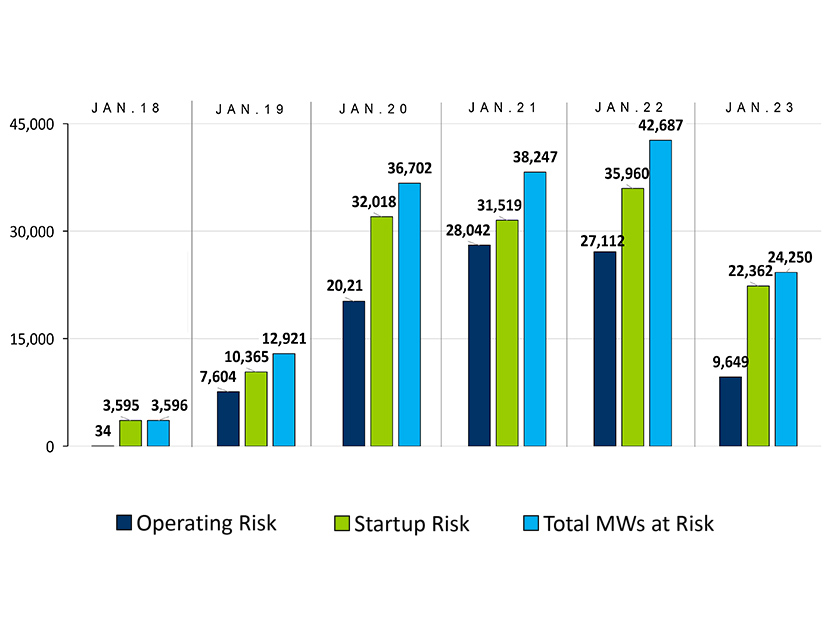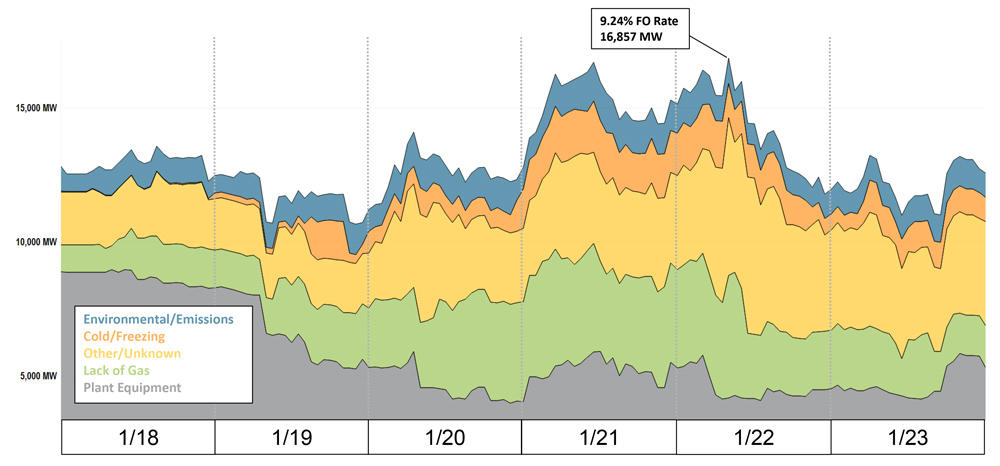
Resource Performance Improves During January Winter Storms
VALLEY FORGE, Pa. — PJM credited emergency procedures with improving generator performance during a pair of winter storms in January, including a new all-time winter peak of 145,060 MW on Jan. 22.
Executive Director of System Operations Dave Souder told the Operating Committee on Feb. 6 that PJM identified as much as 42,687 MW of generation at risk of not being able to perform during the extreme cold days because of a combination of potential start-up and operational issues.
Emergency procedures such as conservative operations allowed dispatchers to schedule units in advance to ensure they were running when cold weather began and to avoid cycling those units on and off if they might have trouble restarting. The conservative operations emergency procedure was established following December 2022’s Winter Storm Elliott.
Tests also were scheduled a week in advance of the storms, with about 20% of tested units running into mechanical issues that largely were able to be resolved before the storms began.
The forced outage rate peaked at 9.24% on Jan. 22, with 16,857 MW offline because of lacking gas for fuel, equipment failures, freezing temperatures and other causes. The forced outage rate during Elliott was 24%, and it was 22% during the 2014 polar vortex.
Souder said PJM continues to refine the risks that are incorporated into its determination of what resources are considered at risk ahead of periods of high system strain. Part of that is the cold weather operating limits created after Elliott, which allow generation owners to report conditions that could impede resource performance.
Senior Vice President of Operations Mike Bryson said generation owners also were more diligent about reporting operating restrictions on their units, giving dispatchers more insight into the status of the fleet and what units were most likely to be available. Generation owners also were forthcoming about how they procure fuel and how their strategies could interact with PJM dispatch instructions. As stakeholders consider changes to the intersection between the electric and gas sectors, Bryson recommended avoiding one-size-fits-all approaches that would not recognize those differences.
“We have probably 40 different flavors, so what was important was for each [generation owner] to tell us what their strategy was,” he said.
Paul Sotkiewicz, president of E-Cubed Policy Associates, said the performance data show the idea that gas generation struggles to meet its obligations during winter storms is untrue. He argued that if gas resources had been provided advanced commitments as they had in January, their performance would have been significantly better. He said this raises questions about how gas should be modeled in PJM’s effective load-carrying capability risk modeling and accreditation framework if a significant amount of the class’ risk comes from how it is committed.
“Now that we understand everything, why is gas being punished” for how it was dispatched under a different set of rules? he asked.
Sotkiewicz also said PJM should find a venue where the interactions between market design and dispatcher actions can be discussed. He said the two presentations PJM gave on the storm during the Market Implementation Committee and OC meetings were siloed into each committee’s scope, limiting the ability for stakeholders to have substantive discussion.
“Markets help determine the reliability outcomes … and now we’re separating these two into silos, and I fear we’re going to be losing a lot of details doing that,” he said.
January Operating Metrics
PJM saw an average hourly forecast error rate of 1.67% during January, with two days exceeding the RTO’s 3% peak error benchmark, Marcus Smith, lead engineer for markets coordination, told the OC.
Smith attributed a 3.54% peak load overforecast on Jan. 20 to the impact of the Martin Luther King Jr. Day holiday weekend, and a 3.67% overforecast of the Jan. 28 peak to temperatures being significantly higher than expected.
Winter storms led to several emergency procedures and alerts being declared, including a conservation alert, maximum generation alert, spin event, low voltage alert, six cold weather alerts and six shared reserve events.
The spin event was initiated Jan. 21 at 12:20 a.m. and lasted four minutes and 40 seconds, with 694 MW of generation and 40 MW of demand response being committed. Performance for generation resources was 160% and 139% for DR.
Other Committee Business
Stakeholders endorsed by acclamation revisions to Manual 40: Training and Certification Requirements drafted through the document’s periodic review. The changes include updating references to PJM departments and clarifying that member training liaisons should respond to RTO-initiated data verification requests.
The committee also endorsed by acclamation revisions to Manual 14-D: Generation Operational Requirements conforming to FERC’s order accepting PJM’s generation operational testing requirements (ER24-99). The testing is one component of a larger proposal that came out of the Critical Issue Fast Path process the RTO conducted in 2023.
The revisions allow PJM to initiate two tests each in the summer and winter with the aim of validating that resources are able to operate as needed for reliability. If a resource fails a test, it can be required to undergo a retest, which, if also failed, would subject the unit to a daily generation capacity resource operational test failure charge.
Finally, the OC endorsed by acclamation a proposal to sunset the Data Management Subcommittee and shift its work to a new Modeling Users Forum. PJM’s Jeff Schmitt said the change would allow for a focus on long-term goals and initiatives.

